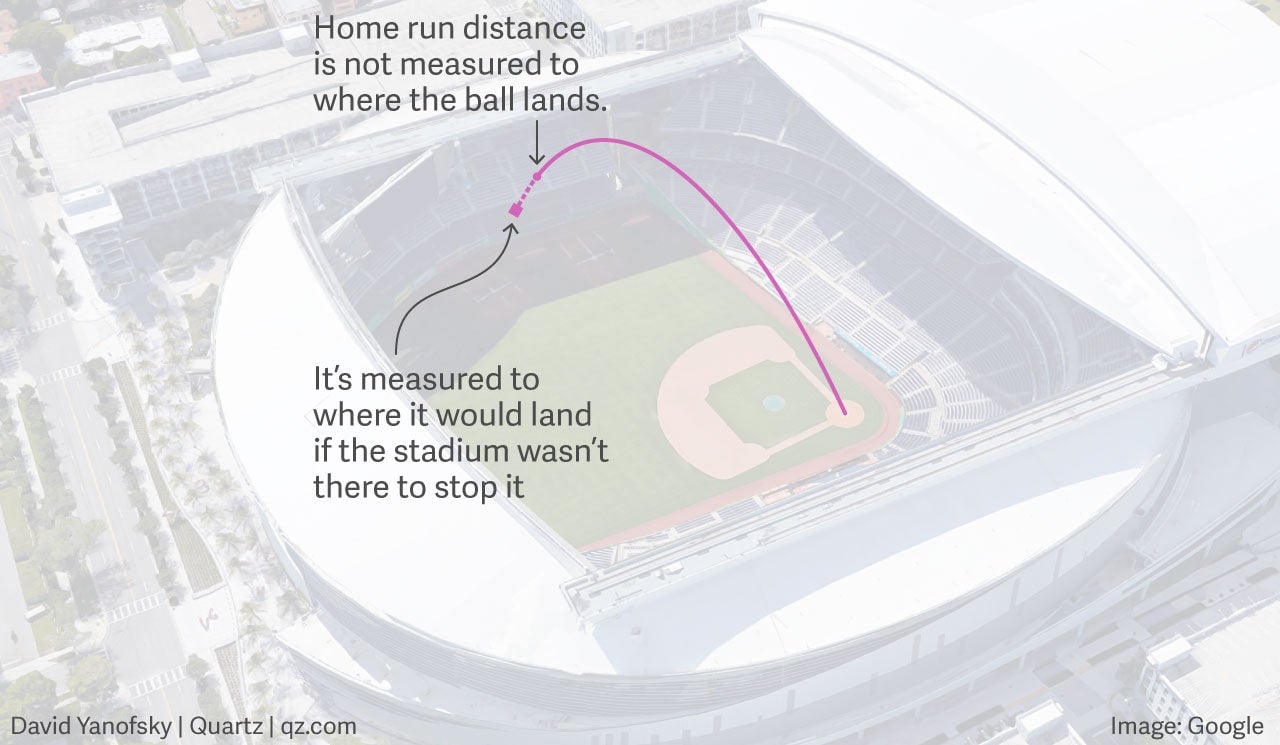Why calculating home run distances is like measuring sea level
It seems like it should be simple to calculate the distance of a home run: We know where the ball starts (at home plate) and 99% of the time we can see where it ends up.


It seems like it should be simple to calculate the distance of a home run: We know where the ball starts (at home plate) and 99% of the time we can see where it ends up.
But this still doesn’t account for a key physics problem, hidden in plain site: When a home run lands in the outfield stands—or perhaps hits a pole or facade—the ball stops moving at a point elevated from field level, sometimes by as much as 200 feet. To figure out how far the ball would have traveled if unimpeded—and therefore get the “true distance” of a home run—we need to figure out the exact trajectory the ball took and then extend that to field level.

For most of the history of professional baseball, home-run distances were determined by a process we could charitably call “estimation.” There is no official all-time record holder in home-run distance, though New York Yankee outfielder Mickey Mantle’s home run on April 17, 1953 in Washington, DC’s Griffith Park is often referenced as the longest ever recorded. In the public record, it was hit 565 feet. But that number came from a Yankees publicist, Red Patterson, who claimed to have found the spot where the ball landed outside the stadium, and measured the final distance. (Alan Nathan, professor emeritus at the University of Illinois, did a forensic analysis of the Mantle home run and story, and came up with a somewhat smaller number).
According to Inverse, in 1990, scientist Syd Mandelbaum figured out a way to apply a method he had been working on to measure things on the microscopic level (like the distance between blood cells) to better calculating home-run distances. As Mandelbaum told Inverse: “I was able to use an overhead photo of a ballpark, taken directly down 90 degrees. I entered that into my computer, and we were able to enter X and Y measurements and measure specific distances on the photograph.”
The X measurement was the distance from first to third base (standard across all stadiums) and the Y measurement was from home plate to the outfield wall in straightaway center (different in each field, but pre-measured and known). From there, Mandelbaum could get a pretty decent estimate for anything that landed in the outfield stands. Put another way, he used geometry. Mandelbaum’s design was used for more than a decade throughout major league baseball.
Then in the mid-2000s, Greg Rybarczyk, an engineer and former US Navy officer, developed a spreadsheet tool called Hit Tracker that takes in data on atmospheric factors like wind speed, temperature, and altitude, and observable event information like the speed and angle of the ball as it leaves the bat, the time the ball flew through the air, and the location of the final point of the ball’s flight. It’s an elegant solution, and similar to the method scientists have used for years to calculate distance above sea level.
“Sea level” is not actually uniform; the height of the ocean’s surface relative to the center of Earth can vary by hundreds of feet from point to point. And of course, when you’re on land, there isn’t any sea directly beneath you. So, scientists developed equations that enable us to input variables like atmospheric data (in this case, things like local gravitational force) and observable information (like the positions of the GPS receivers and satellites likely being used to establish the measurement point), to get an estimate of what the sea level would be, if there were a sea below your feet.
Rybarczyk’s Hit Tracker became far and away the most accurate means to determine the true distance of an in-game home run, and has been officially in business since 2009, when the technology was licensed to ESPN and released to the public as “Home Run Tracker.” In that time, the longest home run recorded was hit by another Yankee outfielder: Aaron Judge, whose June 11, 2017 homer travelled a true distance of 496 ft. (In 2015, MLB’s Statcast system launched its own version of a “true distance” estimator, which uses a formula similar to Rybarczyk’s. Judge’s homer, by its count, went 495 ft.)
Tonight, Judge will participate in MLB’s 2017 Home Run Derby, where the winner is determined by who hits the most home runs. But distance still counts for something, both practically—each hitter gets 30 seconds of bonus hitting time for launching at least two home runs over 440 ft.—and aesthetically: Almost certainly, the number you’ll see most in tomorrow’s headlines won’t be the player’s home run total, but the true distance of the longest single homer.